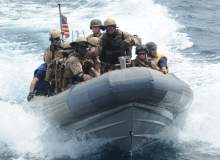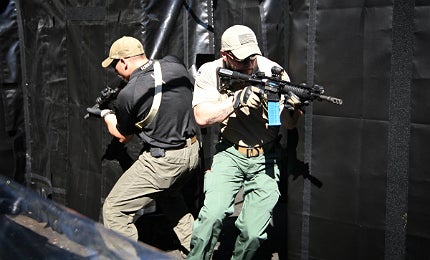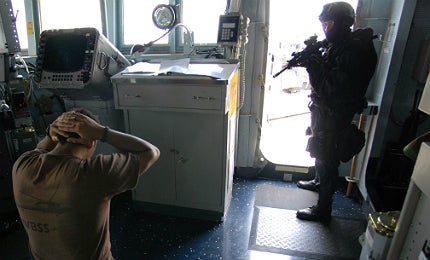
Despite the rapid shrinking of the global map, the open ocean can still be a dangerous place. In hotspots such as Africa’s east and west coasts, pirates and militants regularly carry out audacious attacks on cargo vessels and other ships in search of valuables and hostages.

Discover B2B Marketing That Performs
Combine business intelligence and editorial excellence to reach engaged professionals across 36 leading media platforms.
While attacks of this nature are more commonly aimed at merchant vessels, the geopolitical stakes are raised even higher with the offshore oil and gas industry. Attacks on major oil and gas infrastructure have the potential for not only tragic human consequences, but also damaging destabilisation of the world’s hydrocarbon-based energy supply.
A series of significant attacks on oil and gas facilities and vessels in Nigerian territory between 2006 and 2010 showed just how harmful these security breaches can be, for both the victims and the wider industry. A sustained campaign of attacks on oil and gas infrastructure offshore of Nigeria and in the southern Niger Delta during this period reportedly resulted in more than 200 foreign workers being taken hostage and reduced Nigeria’s oil production by around 25%.
In recent years, the growing profile of piracy and other offshore attacks has provoked a ramped-up response from the global community, with a heightened onboard security presence and multilateral naval escort initiatives making most vessels and offshore installations a much tougher target for potential assailants.
But the tragic outcome of the recent hostage situation at an onshore oil and gas facility in Algeria highlights the strategic priority that militants assign to vital energy infrastructure such as oil rigs, platforms and tankers.

US Tariffs are shifting - will you react or anticipate?
Don’t let policy changes catch you off guard. Stay proactive with real-time data and expert analysis.
By GlobalDataChallenging the offshore training status quo
For Brad Barker, president of US-based security consultancy Halo Corporation, a major flashpoint like the hostage crisis in Algeria often serves to shake up the best practices for security training. "Why do you have to get punched in the face a few times before you learn how to block?" he asks.
Simple human nature and its tendency towards complacency might provide the answer to that question, but Barker makes a compelling argument that cutting-edge security training should always be looking to challenge the status quo.
In the case of offshore security training, the status quo in question is dominated by theoretical workshops followed by on-the-job training on an actual oil platform. "The overwhelming majority of training programmes go from a PowerPoint to an actual GOPLAT [gas and oil platform]," Barker says.
Halo, along with its training partner Strategic Operations, has been introducing ‘reality-based training’ to US military forces during the last few years, with Strategic Operations delivering its courses to more than 600,000 members of the US army, air force, navy and marines.
Reality-based training, or hyper-realistic training, emphasises practical training scenarios in highly faithful military environments, including the physical simulation of battlefield injuries and the provision of trained military role-players to act as the opposing force (OpFor).
Barker would like to see a little of this realistic methodology cross into offshore security training, as the data pulled from using reality-based training demonstrates the powerful ‘stress inoculation’ effect it can have on operators, making them less prone to hesitance if an emergency springs up.
"When you go from flash to bang in a scenario, no matter how much training you’ve had in the historical ‘death by PowerPoint’ method, a fair amount of people are going to be startled; they’ll flinch or go into shock," Barker says. "You can’t operate at your highest potential when you’re in shock. If you run through a bunch of controlled, hyper-realistic scenarios, you’re not going to be shocked when it happens for real. It’s not that they’re used to it, but they’re dramatically less likely to go into a state where their responses are going to be debilitated."
Bringing realism to offshore training
It’s an interesting concept, but the offshore security environment is vastly different from the conditions faced by the majority of military forces. Without much precedent to rely on, how could a modern, reality-based training regime be transplanted into the routines of security personnel keeping watch over oil platforms and vessels in potentially unstable regions, as well as the military units that are called into action in the case of a crisis?
Barker proposes a mix of virtual and physical training exercises, using scenarios and environments that are specific to offshore security. This would allow personnel to receive the ‘stress inoculation’ benefits of immersive training before ever setting foot on an actual platform or vessel.
Creating a virtual training environment using virtual reality goggles or screens is an effective and attention-grabbing way of running through an infinite variety of drills without any real-world risk, Barker argues. "[It allows] the operators to train in a virtual environment where you take CAD [computer-aided design] drawings and immerse the operator into a virtual reality scenario where they have 360-degree immersion, using goggles or screens to emulate the scenario," he says.
The novelty appeal of virtual training systems is engaging for trainees, and Barker is confident the technology has advanced far enough to be useful. "PowerPoint makes most of these operators gag anyway, so when you show them this new, hyper-realistic virtual reality programme, there’s a bit of a novelty there," he says. "When you run a timer against them and let them know that there are skills and routines and behaviours that they must do, and that there are consequences, you bring the emotion up. And then you can throw a little competition in there, which is self-induced urgency."
But this virtual regime would have to be complemented by drills that physically recreate typical offshore oil and gas environments and the scenarios that security forces might come up against. Training on a land-based mock platform or boat is vital for building familiarity through endless, well-crafted drills based on known threats. After all, as Barker says: "It’s very hard to climb a virtual ladder."
"So you transfer to the mock GOPLAT that is kitted or built, or a boat in a box, where they can do VBSS [visit, board, search and seizure] training. This is how operators might board a GOPLAT or seize a GOPLAT that’s been taken. It allows them to drill in a controlled environment with real kit and the weight of real kit, with weapons if need be, using real ropes and so on. And then you can put the OpFor in there, so you have people role-playing as bad guys who are going to make their day a little worse.
"You can run a bunch of different scenarios, up to and including hostage scenarios, chemical or biological hazmat, or Deepwater Horizon-type scenarios. You can bring a bunch of different experts in who are less security-minded that your security team must protect – so they have to complete the mission as well as bringing the guests along. You can really run as many scenarios as far as east is to west, making it as realistic as possible, and nobody has left a single room."
Intel and interoperability
Reality-based training emphasises practical training scenarios
Of course, offshore security isn’t just about getting boots on the ground in an emergency. Many offshore operations are located off the coasts of countries with complex and evolving socio-political situations, and Barker notes that any next-gen offshore security training programme would need to heavily emphasise in-depth knowledge of local conditions to defuse potential threats before they arrive.
The increasing threat of cyber-attacks, prompted by the plummeting price of computer technology, and evidenced by the alleged attempt to hack into the communication networks of Iranian offshore platforms in October 2012, makes reliable intelligence and a varied surveillance strategy (both physical and online) all the more important.
"The ultimate security professional doesn’t have to respond because the crisis was avoided," Barker says. "If you can look at a chronological timeline in front of you, right there in the middle of it is the flashpoint, the incident, or what we call the ‘bang’. What we want to focus on with our immersive training, and using intel, is ‘left of bang’, or prior to the incident. It’s looking at the pre-incident issues, the pre-incident indicators, the behavioural recognition patterns of people who might be coming close to your sensitive infrastructure, and looking at your surveillance technology and tracking the metadata to find out if there are patterns that emerge."
Another factor that offshore security operations have to take into account is the need to collaborate with the many stakeholders involved in protecting energy infrastructure, including private security contractors, the naval forces of the host nation, guest military units and even non-governmental organisations (NGOs). Joint training programmes, such as the one carried out by the US Navy in spring 2009 to improve responses to offshore threats in the Gulf of Guinea, are essential in regions where separate military entities must act together.
"If you don’t have incident command structure, you’re going to have a breakdown in communication, co-ordination and collaboration," says Barker. "In those breakdowns are gaps, and in those gaps, people die. So being able to train as you fight, with all available responders in the region, that helps everyone. If you can train together, that’s an excellent opportunity and if it’s not taken, it’s negligently wasteful."
Whether the offshore security world will rapidly embrace cutting-edge virtual and hyper-realistic training methods remains to be seen. But as the technology and techniques behind this kind of training are continually improved, it has now reached a point where it is unlikely to go away. And in an unpredictable offshore environment, perhaps a shake-up of the security training status quo is just what’s needed.
Related content
High risk, high reward: talking offshore oil security with Drum Cussac
Kidnapping and piracy are serious risks for offshore oil companies, but a good set of ground rules and a crack security team can turn the tide.
Cloak of invisibility: shielding oil rigs from rocky waves
A new approach to invisibility cloaking may one day be used at sea to shield floating objects, such as oil rigs and ships, from rough waves.







